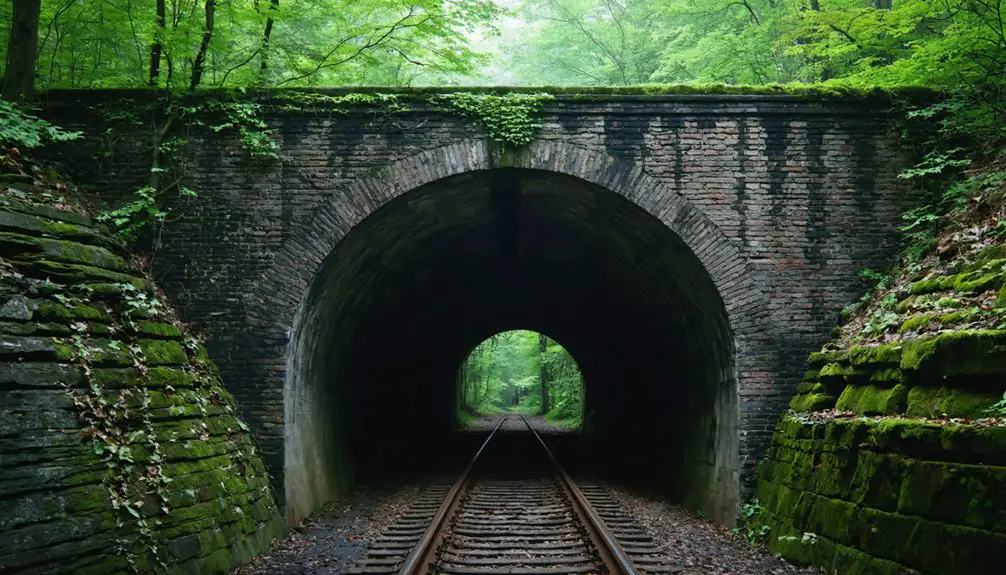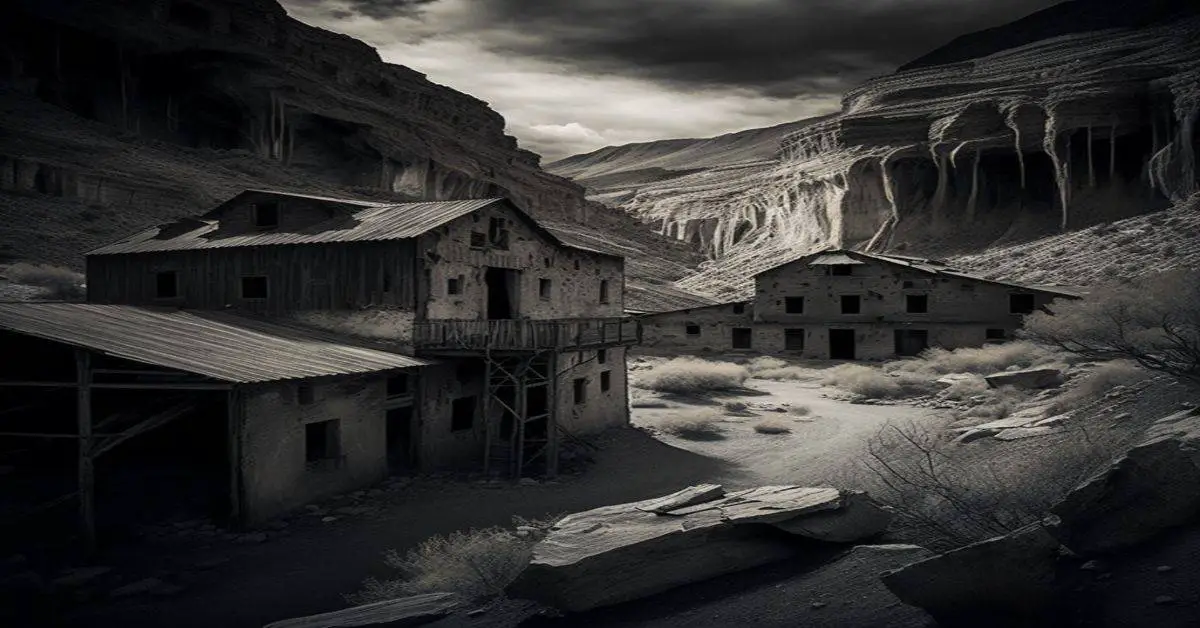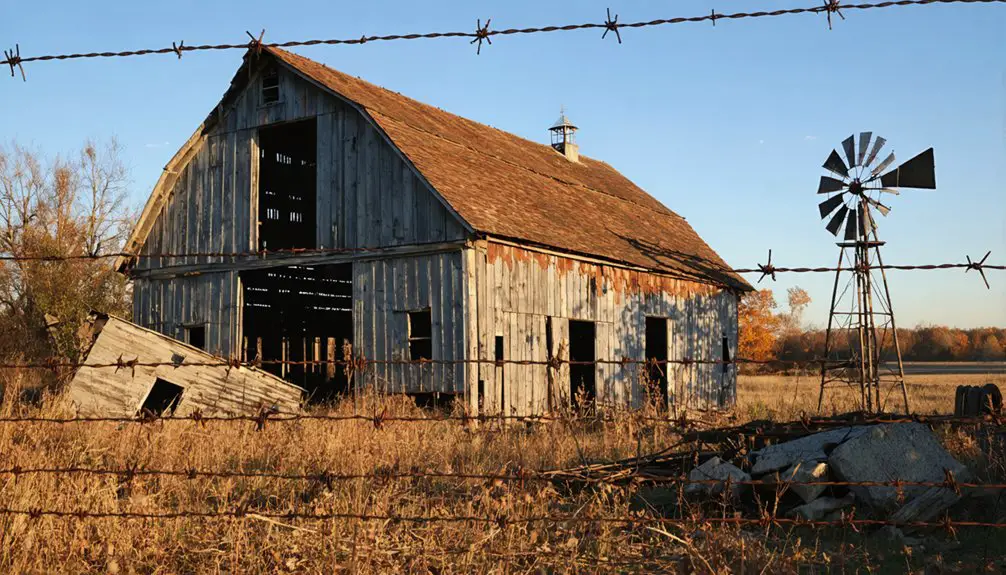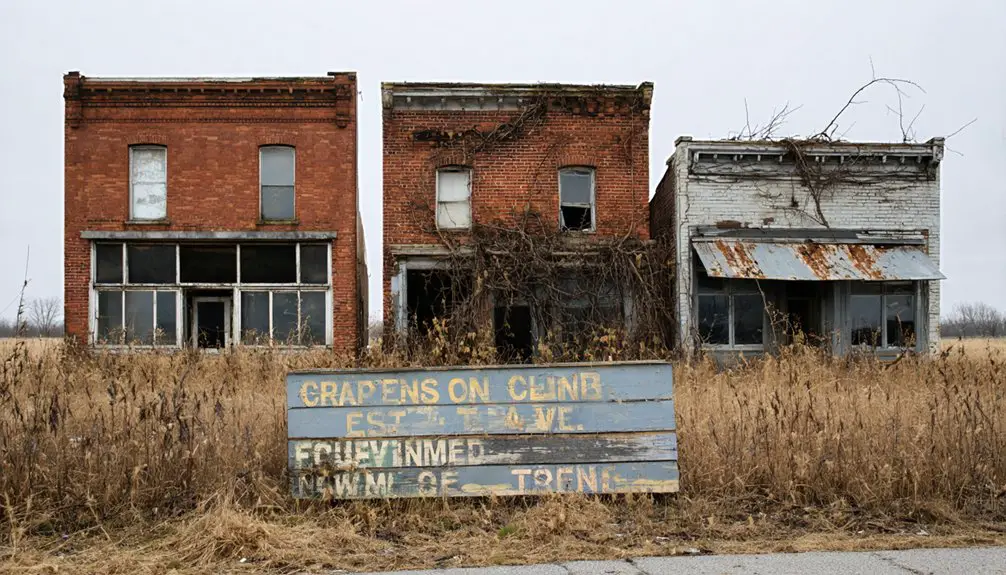You’ll find Moonville’s haunting remains tucked away in southeastern Ohio’s dense forests. This former mining community emerged in 1856 when Samuel Coe offered land to the Marietta and Cincinnati Railroad, growing to over 100 residents near the infamous Moonville Tunnel. The town thrived until coal mines closed in the early 1900s, with the final family departing in 1947. Today, only stone foundations and a tunnel steeped in paranormal lore invite curious explorers to uncover its mysteries.
Key Takeaways
- Moonville was an isolated mining town in Ohio that peaked at over 100 residents before becoming completely abandoned by 1947.
- The town’s existence centered around railroad operations and coal mining, with the iconic Moonville Tunnel being its most notable remnant.
- Economic decline began in the early 1900s when local coal mines closed, forcing residents to relocate to nearby communities.
- The historic Moonville Tunnel, associated with multiple fatalities and ghost sightings, now attracts paranormal enthusiasts and history buffs.
- The Moonville Rail Trail Association actively preserves the site’s history through guided tours and annual events like Midnight at Moonville.
The Birth of a Railroad Town
When Samuel Coe offered free land to the Marietta and Cincinnati Railroad in 1856, he set in motion the birth of Moonville, Ohio. This strategic move marked the beginning of an ambitious railroad expansion through Vinton County’s rugged terrain.
You’ll find the town’s origin deeply connected to the railroad company’s decision to cut through dense woods and cross Raccoon Creek, requiring the construction of the now-famous Moonville Tunnel and two essential trestles. In 1883, the rail line’s operations were transferred to the Baltimore and Ohio Railroad.
The community dynamics quickly took shape around Mr. Moon’s general store, which gave the town its name. As the railroad established its depot and supporting facilities, you’d have seen coal miners, railroad workers, and farming families settling into homes scattered throughout the hollows and hills, creating a tight-knit community that would soon peak at over 100 residents. The town thrived until the coal mines closed in the early 1900s.
Life Along the Tracks
Daily life in Moonville centered around the bustling railroad tracks that cut through the rugged terrain.
You’d find a close-knit community of just over 100 residents spread across several miles of hollows and hills, each making their living from the land and rail. The community dynamics revolved around Mr. Moon’s general store, the local schoolhouse, and the essential depot where up to 14 trains would pass daily.
Your rural livelihood would’ve meant working in the coal mines, maintaining the railway, or tending to crops on the challenging terrain. Today, this historic location serves as one of several place name disambiguation sites across America.
When you weren’t laboring at Coe’s gristmill or sawmill, you’d gather with neighbors at local institutions that formed the backbone of this woodland settlement.
Life was simple but purposeful, deeply connected to both the railroad’s rhythm and nature’s demands.
Mining and Industrial Heritage
The heart of Moonville’s existence lay beneath its rugged terrain, where rich coal deposits first caught the attention of industrial prospectors in the mid-1800s.
You’ll find the town’s industrial legacy intertwined with the Ferguson and Coe families, who pioneered local mining techniques while operating sawmills and gristmills in the area.
The Cincinnati and Marietta Railroad arrived in 1856, transforming the small settlement into a bustling mining town.
As part of the Hanging Rock Iron Region, Moonville’s coal fed the hungry furnaces that produced some of Ohio’s finest iron.
The mining operations flourished thanks to industrial advancements like the Marietta and Cincinnati Railroad, which conquered the landscape with impressive trestles and the Moonville Tunnel.
The decline of the coal mining jobs in the early 1920s led to the community’s eventual abandonment, leaving behind only scattered foundation stones as testament to its industrial past.
The Infamous Moonville Tunnel
Standing as a haunting reminder to Ohio’s industrial past, the Moonville Tunnel cuts through a steep hillside near Hope in Vinton County. Built in the 1850s during the railroad expansion, this stone and brick passage emerged when Samuel Coe granted the Marietta and Cincinnati Railroad free access through his land.
You’ll find the tunnel’s narrow design proved deadly throughout its history, claiming over 21 lives. The most famous incident involved engineer Theodore Lawhead’s fatal collision in the 1880s. Less than 50 yards from the tunnel’s mouth, you’ll spot the railroad trestle spanning Raccoon Creek, where the last recorded death occurred in 1978. At its height, the surrounding community supported a population of 100, with residents often walking the tracks due to the absence of proper roads.
Today, while Moonville’s buildings have vanished, the tunnel stands as the ghostly centerpiece of a multi-use trail, drawing visitors fascinated by both its rich history and reported paranormal activity. The tunnel lies within Zaleski State Forest, offering numerous hiking opportunities for outdoor enthusiasts.
Tales of Tragedy and Loss
Throughout its brief existence from the 1850s to 1947, Moonville’s isolated location and dangerous railroad infrastructure created fertile ground for tragedy, claiming over 21 lives near the tunnel and trestles.
Despite showing remarkable community resilience, the town couldn’t escape its deadly reputation. The worst incident occurred in 1880 when two trains collided head-on, killing engineer Frank Lawhead and his fireman. Ghostly apparitions were first reported in local newspapers in 1895.
You’ll find stories of railroad workers who lost their lives, including an intoxicated brakeman whose lantern-carrying spirit supposedly haunts the cemetery. The small town peaked with 100 residents in 1870, before its gradual decline began.
The economic decline hit hard as coal mines closed, forcing families to abandon their homes. By 1947, even the stubborn Coe and Ferguson families had left.
The final recorded tragedy struck in 1978 when a 13-year-old girl fell from a trestle during a train passing.
Paranormal Phenomena
As you approach Moonville Tunnel, you’ll frequently encounter reports of ghostly trainmen in period uniforms, swinging lanterns in the darkness.
The phantom lantern signals have caused such confusion among real train operators that officials installed a permanent signal light in 1981 to prevent unnecessary stops.
The most notable spectral figure you’ll find is the “Moonville Engineer,” who reportedly fell to his death on the tracks and now appears regularly near the tunnel entrance, his ghostly form vanishing when visitors draw near. The tunnel’s eerie reputation grew due to its location in Ohio’s densest forest, making it one of the most isolated and desolate railroad passages of its time.
Ghostly Train Sightings
Since the late 19th century, the abandoned rail lines of Moonville have drawn paranormal investigators and curious visitors seeking glimpses of its most famous spectral resident – Theodore Lawhead, a railroad engineer who died in a tragic train collision.
You’ll find reports of ghost train encounters throughout the area, particularly near the eastern end of the Moonville cut. Witnesses describe seeing Lawhead’s apparition dressed in white, his flowing beard and glowing eyes visible as he swings a mysterious lantern across the tracks.
Even after the line’s abandonment in 1988, phantom locomotive sightings continue, accompanied by inexplicable rumbling sounds and whistles. These supernatural events intensify during twilight hours and stormy nights, with the spectral activity reaching its peak at midnight and during full moons.
Lantern-Wielding Spirits
While mysterious lights dance through Moonville’s abandoned rail line, none have captured the public’s imagination quite like the lantern-wielding spirits of Moonville Tunnel.
You’ll find these spectral figures most active at night, swinging their phantom lanterns in what appears to be urgent warning signals to passing trains.
Since the railroad’s heyday, over 21 documented deaths near the tunnel have fueled reports of ghostly warnings from these ethereal railroad workers. Their lantern sightings became so prevalent that in 1981, officials installed a modern signal light – partly in response to engineers who’d stop their trains after spotting these supernatural signals.
Today, you can join ghost hunters and locals at the annual Midnight at Moonville festival, where these spirits continue their eternal vigil along the old Marietta and Cincinnati Railroad route.
Exploring the Remnants Today
When you visit Moonville today, you’ll find the iconic tunnel accessible via a winding forest path that follows the old railroad bed through Zaleski State Forest.
Your exploration can continue to the nearby Moonville Cemetery, where weathered headstones tell stories of railroad workers, miners, and their families who lived and died in this once-bustling community.
Following the former rail line further, you’ll discover scattered foundation stones and remnants of trestles that mark where buildings and infrastructure once stood in this abandoned mining town.
Tunnel Access and Safety
Today’s visitors to Moonville Tunnel can access this historic site through a convenient trailhead located on Hope-Moonville Road near Moonville Cemetery.
You’ll find parking available and a short 0.2-mile walk to reach the tunnel entrance along the Moonville Rail Trail.
As part of ongoing tunnel preservation efforts, you’re welcome to explore during daylight hours from 6 a.m. to 11 p.m.
Visitor safety measures include restrictions on motor vehicles, camping, and fires. You’ll need to keep your dogs leashed and stay on marked trails to avoid hazards like uneven terrain and structural vulnerabilities in this 1850s brick-lined passage.
While you’re free to photograph and explore the tunnel, remember that after-dark visits require a special permit, and any group events shouldn’t restrict public access.
Cemetery’s Hidden Stories
Beyond the tunnel’s brick archway, Moonville Cemetery rests quietly on a hillside past an iron bridge, offering a poignant glimpse into the town’s vanished community.
You’ll find at least 13 known graves here, though gentle indentations in the soil hint at hidden histories beneath your feet. The Coe and Ferguson families’ plots tell stories of the area’s central mining families, while other forgotten lives found their final rest in nearby Keeton Cemetery or Zaleski.
Time and neglect have taken their toll – fallen trees and vandalism have erased many markers, leaving only whispers of those who once called Moonville home.
Yet these grounds remain one of the last physical connections to the community that vanished by 1947, drawing historians and paranormal enthusiasts who seek to uncover its mysteries.
Railroad Foundation Discoveries
Along the abandoned Baltimore & Ohio rail line, you’ll find the remarkable remnants of Moonville’s railroad heritage scattered through dense southeastern Ohio woodland.
The massive stone tunnel, carved through Ferguson’s hillside in 1856, stands as the most impressive railroad artifact from the area’s mining heyday. You can trace the old rail bed, now transformed into a recreational trail, to discover foundation stones of former buildings and two historic trestles spanning Raccoon Creek.
These engineering marvels once supported coal trains servicing regional furnaces, including Hope Furnace. While the rails and ties were removed in 1988, the tunnel’s historical significance endures as a symbol of the industrial age that transformed this remote valley into a bustling transportation corridor.
Local Legends and Lore
While Moonville’s abandoned tunnel stands as a silent tribute to its railroad past, the structure harbors some of Ohio’s most enduring ghost stories.
Local folklore tells of five distinct spirits, including Theodore Lawhead, a railroad engineer killed in an 1880s collision, and the mysterious Brakeman whose lantern still drifts through the darkness.
You’ll hear tales of the Lavender Lady, the vengeful Bully who throws pebbles at visitors, and the towering figure of Rastus Dexter.
Ghost encounters at the tunnel often include unexplained lantern lights, phantom train whistles, and shadowy figures along the tracks.
With over 21 documented deaths in the area, these stories have become deeply woven into the community’s fabric, celebrated annually at the Midnight at Moonville Festival and preserved through generations of storytellers.
The Town’s Slow Disappearance
As you look at Moonville’s decline in the early 1900s, you’ll find the local coal mines steadily shutting down as their resources became depleted.
The loss of mining jobs triggered a gradual exodus of residents to nearby towns and cities with better economic prospects.
The final chapter of Moonville’s inhabited history came in 1947, when the last remaining family packed up and left the once-bustling mining community.
Mining Operations Close Down
The depletion of coal, clay, and iron ore resources marked the beginning of Moonville’s decline in the early 1900s.
You’d have seen the mining decline unfold as coal seams ran dry and iron ore deposits dwindled, forcing local mines to shut their doors one by one. The economic impact rippled through the community as the town store, saloon, and other mining-dependent businesses couldn’t survive without their primary customer base.
The Baltimore & Ohio Railroad, which once transported Moonville’s valuable minerals across the region, couldn’t prevent the inevitable.
Population Steadily Drifts Away
From its peak of roughly 100 residents in 1870, Moonville’s population steadily eroded through a combination of economic hardship and geographic isolation.
You’d have witnessed the community’s resilience tested as declining coal deposits drove miners to seek work elsewhere. The population migration accelerated dramatically when a devastating smallpox epidemic struck in the 1890s, making the remote settlement even less appealing for families trying to build a future there.
The town’s isolation, with access limited to dangerous railroad tracks through dense forest, continued pushing residents toward more accessible communities through the early 1900s.
By the 1920s, dwindling numbers had impacted local services, triggering more departures until the last family left in 1947.
Today, only the tunnel and cemetery remain as silent witnesses to Moonville’s vanished community.
Final Family Leaves Town
Following decades of slow decline, Moonville’s final chapter began in 1947 when its last remaining family packed their belongings and left the isolated mining town behind.
You can trace the town’s gradual disappearance through the early 1900s as coal mines closed and employment opportunities vanished. By the 1960s, time had erased nearly all physical traces of the community, leaving only scattered building foundations, the cemetery, and the infamous tunnel.
The final family’s departure marked more than just an empty town – it symbolized the end of an era for mining communities throughout southeastern Ohio.
Yet Moonville’s legacy lives on through its haunting reputation, with the tunnel becoming a magnet for visitors seeking traces of phantom railmen and the town’s mysterious past.
Preserving Moonville’s Memory
Preserving Moonville’s rich history remains an ongoing mission, spearheaded by dedicated organizations like the Moonville Rail Trail Association (MRTA) and Vinton County Park District.
You’ll find preservation efforts focused on maintaining the iconic tunnel, trails, and surrounding landscape while promoting responsible public access. Community involvement plays an essential role through volunteer work, guided tours, and fundraising events.
- Trail bridges spanning Raccoon Creek replace old train trestles
- Daily access from 6 a.m. to 11 p.m. lets you explore freely
- Historical documentation counters ghost story misinformation
- Special events and photography sessions keep the site vibrant
- Local merchandise sales fund ongoing preservation projects
The MRTA’s work continues to connect Moonville with neighboring ghost towns, ensuring this piece of Ohio’s mining and railroad heritage lives on for future generations to discover.
Frequently Asked Questions
What Was the Average Population of Moonville During Its Peak Years?
You’ll find that population trends show this mining community reached around 100 residents during its peak in the 1870s through the late 1800s, when coal extraction was most active.
Were There Any Churches or Religious Gatherings in Moonville?
You won’t find any churches in Moonville’s history. While residents likely practiced faith privately, there’s no evidence of formal religious buildings or community gatherings – they’d travel to nearby towns for worship.
How Much Did Coal Miners Typically Earn in Moonville?
You’d have earned around 81 cents per hour as a coal miner in the 1920s, with daily pay near $6.50. Earlier, in 1902, you’d make about $1.60 for ten hours of tough underground work.
What Happened to the Residents’ Belongings When They Abandoned Their Homes?
You’d think ghost town artifacts would fill a museum, but in reality, residents took valuables when leaving, while abandoned belongings decayed in the forest or were scavenged by locals over time.
Did Native Americans Have Any Significant Presence in the Moonville Area?
You’ll find rich Native tribes’ history in this area, from ancient Adena and Hopewell cultures through Shawnee and Wyandot peoples. Their cultural heritage remains in mounds, artifacts, and “Indian Fields” along Raccoon Creek.
References
- https://en.wikipedia.org/wiki/Moonville
- https://www.moonvilletunnel.net
- https://www.statenews.org/news/2023-10-12/how-the-ghosts-of-moonville-are-keeping-the-towns-history-alive
- https://www.moonvilletunnel.net/Moonville_History.htm
- https://visitvintoncounty.org/history/moonville-tunnel/
- https://www.ohioexploration.com/structures/moonvilletunnel/
- https://blogs.bgsu.edu/elements/2012/03/02/moonville-a-journey-to-the-past/
- http://www.throughthewoods.net/blog/the-moonville-tunnel
- https://ohiomemory.ohiohistory.org/archives/3405
- https://valleyreality.org/the-moonville-tunnel/



